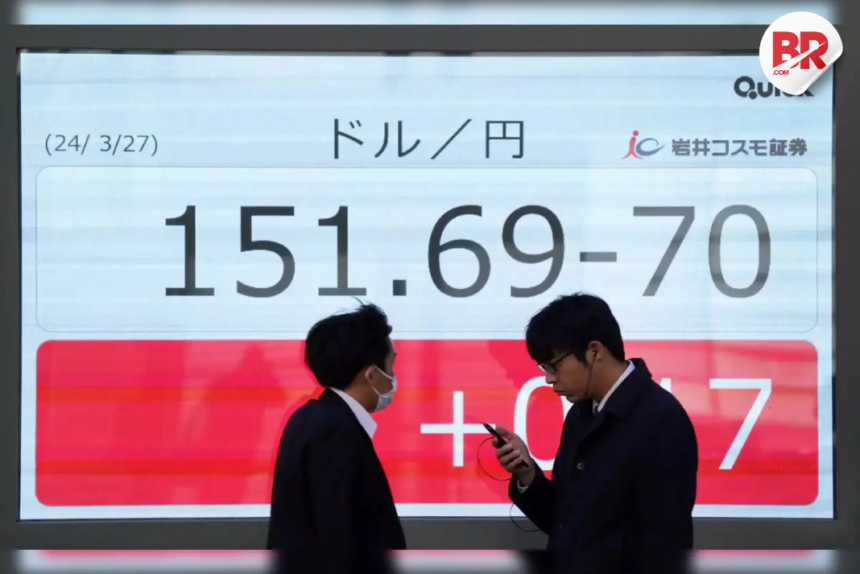
Asia markets decline as trade tensions rise and Nvidia faces new export restrictions, leaving investors on edge.
Shares across Asia mostly saw declines Wednesday, following a rare period of calm in global financial markets, including Wall Street. Amid concerns about U.S. tariffs and a significant setback for Nvidia, investors are feeling cautious. Here’s a breakdown of the major market moves and economic factors affecting Asia’s stock markets.
Nvidia’s Struggles and U.S. Export Restrictions
One of the major stories affecting Asia’s markets this week comes from Nvidia, a key player in the chip-making industry. After-hours trading saw Nvidia’s shares fall 6.3% when the company announced that the U.S. had imposed stricter export controls on its computer chips. These chips are critical for artificial intelligence (AI) applications, which are becoming increasingly central to global tech.

The export restrictions are a part of the U.S. government’s broader strategy to curb China’s access to advanced technology, particularly in AI. This move has already sparked concerns about the impact on global chip supply and technology development. As Nvidia is a leader in this sector, its struggles sent shockwaves through the market, contributing to the regional declines in Asia.
Also Read US-China Tech War Explodes: Why America Just Cut Off China’s Access to AI Chips
Chinese Economic Slowdown Worries
Stock markets in China were hit the hardest after new data revealed that the country’s economy grew at a strong pace in the first quarter of the year. However, despite strong industrial production, retail sales, and exports, growth slowed in quarterly terms. From the last quarter of 2024 to January-March 2025, China’s growth dropped from 1.6% to 1.2%.
Economists have been revising their forecasts downward due to the ongoing trade war between the U.S. and China, which has led to rising tariffs on both sides. This trade uncertainty, particularly President Donald Trump’s decision to increase tariffs on Chinese imports to 145%, has impacted business sentiment. Analysts have warned that the unpredictability of these measures is making companies nervous about future economic conditions.
Regional Stock Market Declines
In Hong Kong, the Hang Seng index saw a drop of 2.5%, closing at 20,922.54. Similarly, the Shanghai Composite index fell 0.9% to 3,237.60. These declines reflect broader concerns about China’s slowing economy and its impact on global markets.
In Japan, the Nikkei 225 lost 0.9%, closing at 22,948.18, while South Korea’s Kospi fell 0.7% to 2,461.45. The Australian market fared slightly better, with the S&P/ASX 200 edging up by 0.3% to 7,781.10. While the overall picture in Asia was one of decline, there were slight gains in some regions, such as Thailand, where the SET index rose by 0.2%.
Also Read US-China Trade War Escalates: Boeing Becomes Beijing’s Latest Target
The Ripple Effect of U.S. Tariffs
The uncertainty surrounding U.S. tariffs has continued to ripple through global markets. Investors are on edge, as they wait to see whether President Trump’s tariffs will escalate further. This has created a tense atmosphere in which businesses and markets are struggling to adjust.
In the U.S., stocks were mostly flat, with the S&P 500 and Dow Jones Industrial Average each falling slightly. However, some companies, such as Bank of America, reported better-than-expected profits, giving a small boost to investor sentiment. The ongoing trade tensions, however, have kept markets on edge.
Impact on Oil Prices and Currencies
The uncertainty over trade and tariffs has also extended to global oil markets. U.S. benchmark crude oil prices fell by 19 cents to $61.14 per barrel, while Brent crude dropped 18 cents to $64.49 per barrel. Analysts believe that slowing economic activity, especially in China, could reduce global demand for oil, further affecting prices.
On the currency front, the U.S. dollar has steadied after a sharp drop last week. The dollar is currently trading at 142.61 yen, down from 143.24 yen. Meanwhile, the euro has gained slightly, rising to $1.1336 from $1.1283.
Also Read Oil Market Just Hit Pause—But for How Long? The Truth Behind the Calm!
What Lies Ahead for Asia Markets?
Looking ahead, the uncertainty surrounding U.S.-China trade relations is likely to continue affecting investor sentiment in Asia. With the U.S. pushing ahead with tariffs and China responding with its own, it’s clear that the global economy faces ongoing challenges.
The continued weakness in Chinese economic growth, combined with the potential disruptions from Nvidia’s setback, suggests that Asia’s stock markets could remain volatile in the short term.
For now, investors will be closely watching any new developments in U.S. trade policies and the broader global economy. With tensions high, Asia markets are in a period of uncertainty, and it may take time for confidence to return.
Also Read Biden Condemns Trump for ‘Breathtaking Destruction’ in Fiery Chicago Speech












